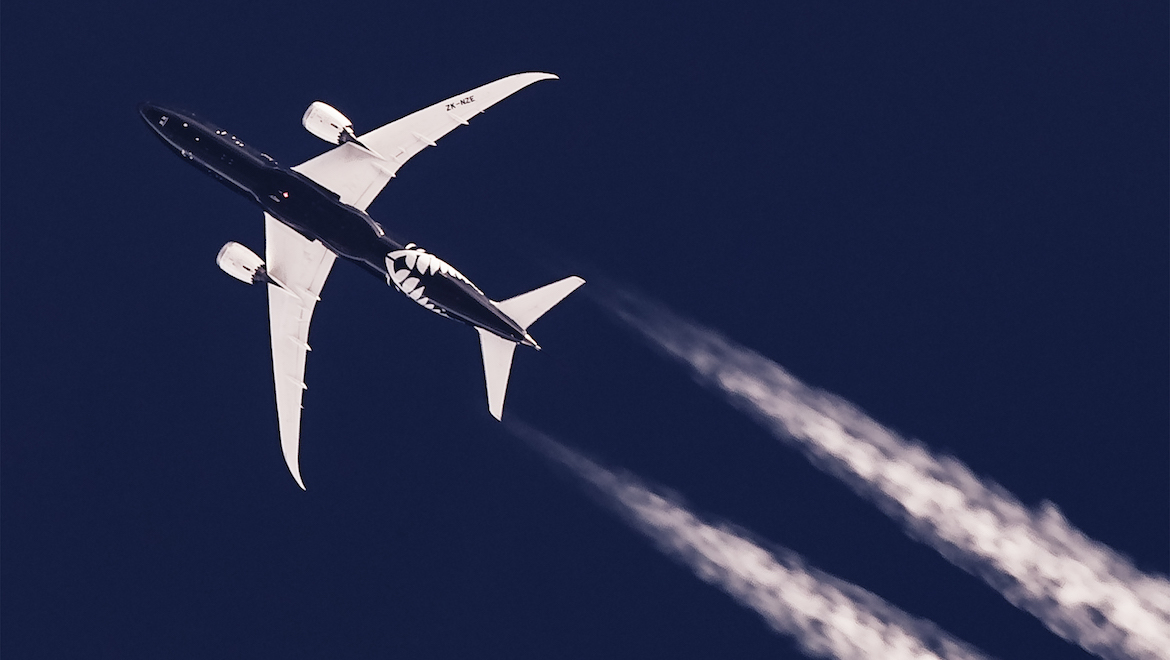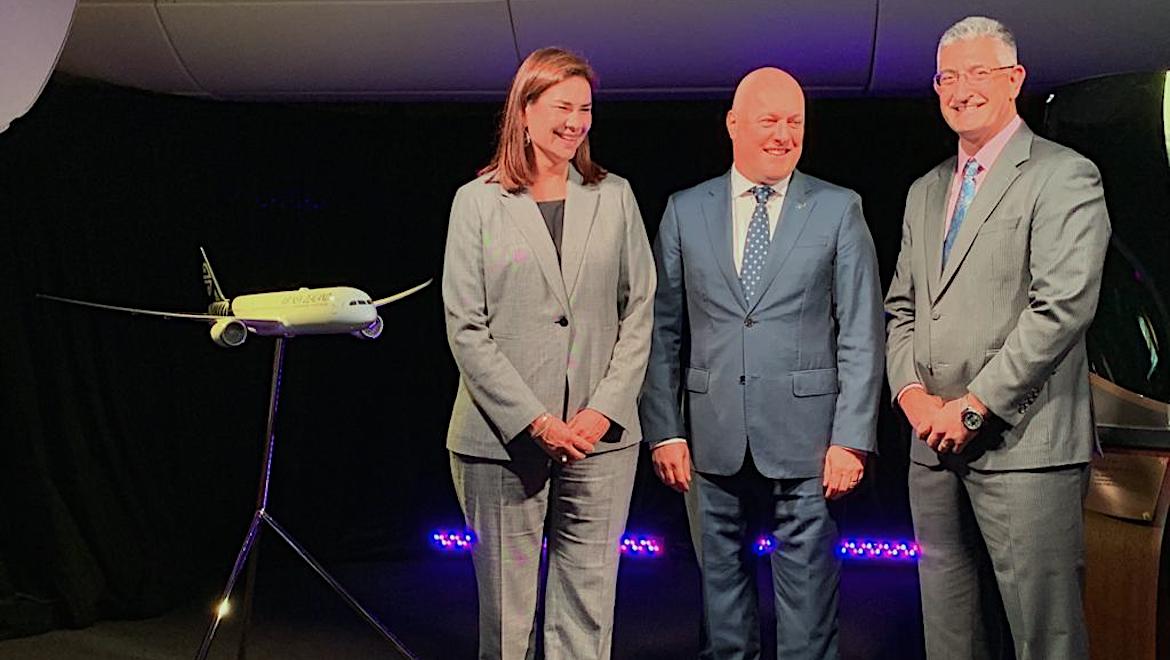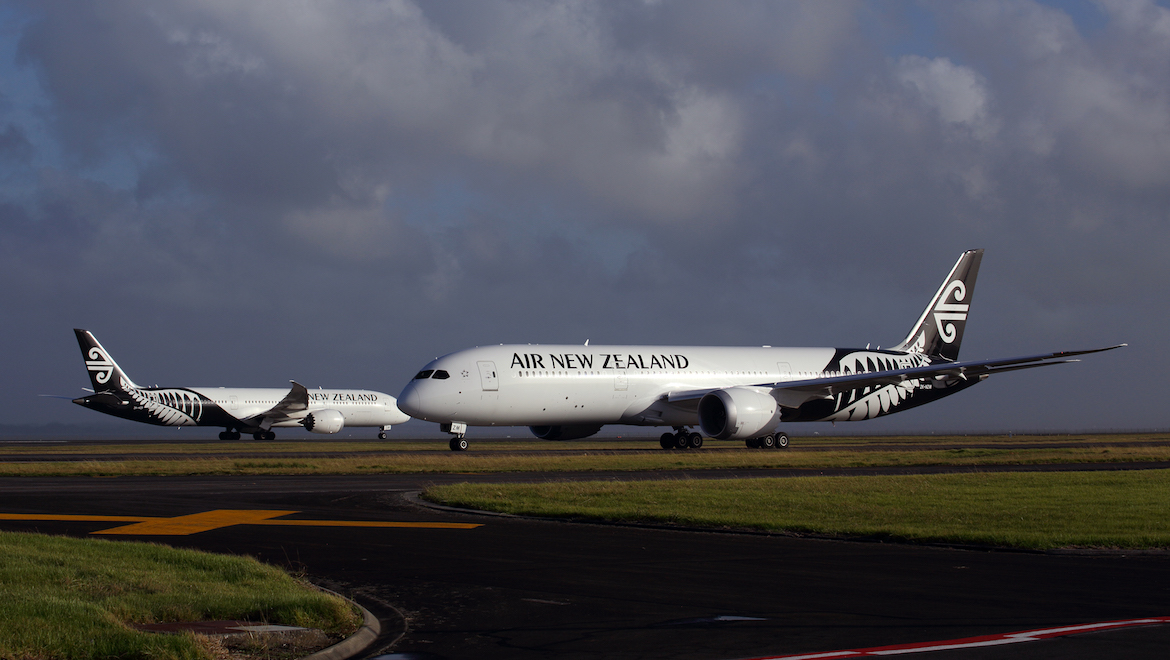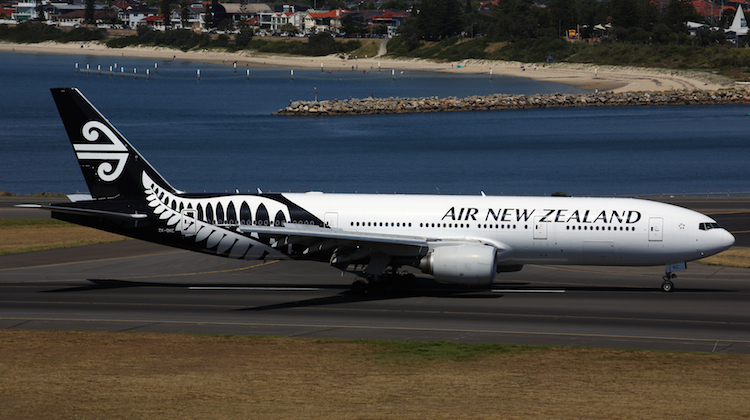This story first appeared in the July 2019 edition of Australian Aviation.

New Zealand’s geographical remoteness lends itself to record-breaking, long distance flights. The Auckland-Doha non-stop by Qatar Airways is the second-longest travelled by any airline in the world.
Air New Zealand’s announcement at the end of May that it has signed a letter of intent to buy eight Boeing 787-10s, with an option for a further 12 aircraft, to replace eight ageing 777-200ERs, confirmed its intentions to become a serious player in the ultra long-haul club.
Cementing this ambition is the fact the option deal includes the flexibility to toggle between 787-9 aircraft and 787-10s, depending on market conditions and routes chosen during the delivery cycle of 2022-2027.
New York was foremost on Air New Zealand chief executive Christopher Luxon’s mind when announcing the new widebody fleet.
He hinted that a service to New York or other eastern ports might even start before the first of the new fleet is delivered.
That’s because the 787-9, with 40 seats fewer than the 787-10, is already capable of flying from Auckland to New York, a distance of 7,671nm (14,207km).
The route is slightly longer that Qantas’s Sydney-Dallas route of 7,454nm (13,804km) and would be an hour longer at 18 hours.
While the 787-10 has 15 per cent more space for customers and cargo than the 787-9 because it is 5.48 metres longer forward of the wing, and uses 20 per cent less fuel, its non-stop flying ability is up to 6,430nm – falling short for direct flights from Auckland to New York .

Air New Zealand was the launch customer of the 787-9 after signing a deal in 2004 for eight aircraft with options of 10 or more. Because of production delays, the first was not delivered until 2014. It now has 13 787-9 aircraft in its fleet with a 14th due for delivery later this year.
Luxon said it was now a matter of working through arrangements with United Airlines, its joint-venture partner in the New Zealand-US market, before announcing a date for the service and the airport it would fly into and out of.
When asked if 2022 or 2023 was in the ballpark, he said it could be. United flies mostly out of New York from Newark Airport, located in New Jersey.
Air New Zealand has earmarked the 787-10s for continuing to service its Pacific Rim routes as well as possible new destinations. Each of its current 777-200ERs that collectively have an average age of 14 years will be phased out upon arrival of each new 787. Luxon said he expected all of the -200s to be out of the fleet by 2025.
The carrier started direct flights three times a week to Chicago on November 30, a distance of 7,189nm (13,184km). The journey takes 15 hours northbound, 90 minutes longer than its direct flights from Auckland to Houston. The return journey from Chicago is 16 hours.
https://twitter.com/FlyAirNZ/status/1132777013058580480
Air New Zealand configured aircraft on this route with 275 seats (known as “Code 2”) due to the higher proportion of business and premium economy seats and, on the Chicago route, a restricted cargo load. Its other configuration for the -9s is 302 seats in three classes.
When launching the Chicago service, Air New Zealand said the 138,000 litres of fuel carried on the aircraft meant it could fly 1,000km beyond Chicago. The distance between Chicago and New York is 619nm (1,147km) but a non-stop flight from Auckland would likely be more direct.
With Qantas also eyeing non-stop flights from Australia’s east coast to London and New York by as early as 2022 as part of its Project Sunrise mission, it could be a race to see who gets there first.

Why choose Boeing?
Luxon said Air New Zealand chose Boeing for its fleet replacement for a combination of reasons.
“We started looking at the route mix we had as well as the passenger mix, which is often different from other airlines,” he said.
“We spoke to lots of airlines about their choices but for us we thought this was a good scenario. We felt the 787-10 gave us the flexibility to do what we wanted to do.”
Luxon said recent criticism faced by Boeing for the way it had done business, particularly after the crashes of two 737 MAX aircraft in Indonesia and Ethiopia, had given Air New Zealand no reason to pause for thought.
He said the airline had known Boeing for more than 50 years, adding it was comfortable doing business with both Boeing and Airbus. It knew both from “top to top”.
“The specific issue around the MAX is the MCAS (Manouvering Characteristics Augmentation System) and it is a completely different aircraft,” he said.
“There is nothing similar available in the 787 family and the 787 is now a well-established platform.
“If you zoom out you have gone from a world where every 25 years you get these big innovation breakthroughs that seem to come in aviation and then things settle down.
“Now we have gone to these two-engine carbon-fibre planes and it has required new airframe and engine development.
“And then there is the demand of 170-odd airlines saying to Boeing and Airbus ‘we want more fuel-efficient aircraft’. So then they go and push three engine manufacturers to deliver those engines. There is quite a lot of new innovation coming through and it partly needs to be settled down, and commissioned and stabilised, as we work our way through it.”

The GE GEnx-1B
On the decision to opt for GE Aviation rather than Rolls-Royce engines – which are on the existing 787-9 fleet – Luxon said the GEnx-1B powerplant gave Air New Zealand “that little bit more fuel-efficiency, which actually helped us getting to where we wanted to get to, and that is really one of the things we weighed up in the end”.
Luxon reiterated that its recent grounding of aircraft because of problems with the Rolls-Royce Trent engines had nothing to do with the airline’s decision to opt for GE. He said the company had treated the issue separately to the order process.
He said the airline had a good relationship with Rolls-Royce and its engines would remain in its present fleet of 13 787-9 aircraft with the 14th due for delivery later in 2019.
“Rolls-Royce is a great operator, a great product. We’ve even taken our whole board to meet with the executive team at Rolls-Royce. We know the company well. It’s got tremendous capabilities but in this instance we felt the deal we got offered from GE, and the combination, was actually a good one,” he said.
“We have known GE for a while as they obviously power our 777-300s, and they have had very good and competitive offers – even if I think about our narrowbody fleets,” Luxon said.
“When we signed up for the Dreamliner back in 2004 it was a concept aircraft, but clearly, as we look at the (GEnx) engine with that fuel-efficiency combined with the -10, we thought it was a great combination. So it was a pretty compelling offer from GE and that was important.”
Luxon said Air New Zealand expects the 787-10s to be 25 per cent more fuel-efficient than the 777-200s they will replace. He said this was helpful, along with the carbon sustainability and the benefits of the customer experience that could be built into the aircraft with a reinvention of the interiors.
“In choosing the most fuel-efficient widebody aircraft and jet engine on the market, Air New Zealand is delivering on our commitment, we believe, to grow our business sustainably,” Luxon said.
“It’s an engine that we have selected for its unrivalled fuel efficiency and its reliability record.”
He said Air New Zealand would now negotiate a maintenance agreement with GE for the engines and the airframes.

What’s on the inside?
Once a new interior was revealed in the first 787-10 in 2022, Luxon said the same cabin profile would be introduced to all of its widebody aircraft.
“We want to make sure we have a consistent widebody fleet. We are one of the few airlines where it doesn’t matter whether you are travelling on a 787 be it -9 or a -10; it is the same product,” he said.
The challenge now with the fleet decision out of the way is, he said, to get the seat configuration right, describing it as the “holy grail” of the business.
The 787-10 has around 15 per cent more space for passengers and cargo.
“With weight around cargo, fuel and passengers, we think there is an opportunity to move to a more premium product,” he said.
After a decade of serving passengers with its lie-flat business class seats in a herringbone configuration of 1-2-1 in the 777s, and 1-1-1 in the 787s, the airline has been quietly overhauling its business class cabin for installation in its new and existing fleet.
At the heart of this transformation is “Hangar 22”, a test area set up in a building near Air New Zealand’s headquarters in downtown Auckland.
The airline is inviting hundreds of frequent flyers to visit the area on a confidential basis for their input on new business class seat designs and other cabin features such as space, storage, privacy and socialising opportunities.

Value over volume
Air New Zealand has been focused on the premium passenger market and New York would be no exception, Luxon said, citing value over volume as a driver for the New Zealand tourism market.
“We don’t want to become a Cancun or a Bali but a Switzerland,” he told reporters in Auckland after the official announcement of the 787-10 order.
He said Air New Zealand and its partners were rather unique because they brought 45 per cent of all visitors to New Zealand.
“No other airline in the world would have that marketshare or responsibility for those visitors,” he said.
“When those visitors are here we want them spending a lot each day in our tourism sector, and that is how we get the productivity and value of our tourism up – we want a high-value customer in that seat.”
He said possibilities for the new 787-10s could involve doing more of what it had done with the 787-9, with the two different cabin layouts of 302 seats and 275 seats.
Luxon said the airline would also be bringing a new economy-plus type product into its aircraft in the middle of 2020.

Flexibility and consistent product
“If you think about the business over the last few years we set off with an order of two Dreamliners back in the day and we’ve now turned it into 14, and we’ve driven a huge amount of growth in the last five, six seven years,” he said.
“We just want to make sure we have massive flexibility and consistent product. Then we send our planes to where we need to, where the economics work.
“I just want that option if we want to grow again, but if the global economy goes bad we can play it both ways.
“Obviously, we have a lot of unencumbered aircraft that are owned with low ownership costs.”
Now that the fleet decision has been made, Luxon said thinking about configuration and working towards route development plans was next, followed by the leasing and funding decisions for the aircraft.
“At Air New Zealand we are very fortunate to have the third highest level of airline investment grade ratings in the world, so we can finance the aircraft really well or we can buy outright.
“We have great cash reserves and are in a good position in a gearing and a financial health sense.”
Luxon said that in the past few years the airline had moved from 50 per cent to 70 per cent ownership of its aircraft, with the balance leased.
“We just work out what are the best commercials to deal with that, either way,” Luxon said.
“Too many times you get locked into the current paradigm. The assumption in aviation is because it is so capital-intensive you have got to define revenue as well as the high cost base around fuel and people and labour. If you . . . lock yourself into an assumption that you are not flexible . . . you can miss out on the opportunities to determine what will happen next.”
He said there were cases where airlines missed out on a decade of growth because they didn’t have the flexibility in place.
Luxon said using a 777-200ER for the Shanghai route was a classic example of having an aircraft that was too heavy and too big when it first started flying there in 2006. Air New Zealand replaced it with a Boeing 767-300ER that flew at full capacity, but with low-value, group travellers from China.

Now, with a 787-9 on the route, Luxon said the airline had found that – in the space of three to five years – it needed more premium seats for higher net worth individuals, as opposed to corporates.
It was an experience that would help inform any non-stop Auckland-New York operation, he said.
“If you can find the right customer out of New York – that is the way we want to go,” Luxon said.
“We know that as markets develop, Argentina is more students and leisure travel. But we are seeing already that as more people do business (between the two countries) the mix starts to change.”
Luxon said the orders and options for the new Dreamliners had been negotiated around both pricing and flexibility with Baden Smith, Air New Zealand’s head of fleet strategy and transactions, doing “some complex and tough negotiation”.
“It’s always complex because so many airlines get those decisions wrong and they miss out for 20 years in participating,” he said.
“A lot of flexibility that was a big part of the focus and making sure that we get that decision right for us.”


“Superb” financial shape
Although the list price for the eight 787-10s is US$2.7 billion (NZ$4.1 billion), Luxon said securing the aircraft as well as options up front meant the airline got a substantial discount on the list price. However, the amount paid would not be revealed.
“It is important to do it upfront because you agree the sort of prices (including options), whereas if you have to do it in three or four years’ time you start at a different price point for negotiation,” Luxon said.
He said the airline was “in superb financial shape” and was fortunate that it had massive cash reserves, a great credit rating, and good levels of gearing to negotiate for the new fleet.
“This is very digestible for us,” he said.
“We have still committed to the same number of aircraft but are just taking them at a slightly slower rate by two years, purely so we can match our growth to our capital expenditure as we see lower levels of growth coming through.”
The aircraft were originally tagged for delivery between 2022 and 2025. That slower rate, Luxon said, would free up NZ$750 million (A$723.6m) in cashflow.
He said since the airline had forecast growth at a more modest three to five per cent range rather than its initial expectation of five to seven per cent “we want to make sure we have capital expenditure linked up with the growth. That is well understood by our investors”.
“In my experience, airlines don’t often match up the supply and demand very well,” he said.
“You’ve seen many airlines go through bankruptcy many times, or massive restructuring. and it doesn’t ever need to be that if you just are ruthless about another scenario reality.
“They don’t face up to their reality in the year and make the necessary adjustments, and all of that gets accumulated over a period of time. Then you are left with some uglier choices you have to make down the road.”

The 777 replacements
Luxon said the question of replacement for the airline’s seven 777-300ERs was a separate decision from the options on the 787-10.
“We’ve actually compartmentalised those decisions so our view at this point is that we would still need a replacement for the 777-300ER,” he said.
“Our intention at this stage is that when the 777-300s come up for replacement towards the mid-to-late 2020s . . . that would be the logical time when we will probably want to look at a larger aircraft. The A350s and the Boeing 777Xs come into the frame.
“At this point the 787-10s (or nines) are not code for replacing the -300s.
“We are really impressed with the candidate aircraft (to replace them). The A350-1000 is a great aircraft, as is the Boeing 777X, though it still has to come through development.”
VIDEO: A look at the delivery of Air New Zealand’s first Boeing 787-9 in 2014 from the airline’s YouTube channel.
This story first appeared in the July 2019 edition of Australian Aviation. To read more stories like this, become a member here.

















Rod Pickin
says:Any airline that has to plan on a continual regulated payload in order to operate a specific route is maybe trying to utilise that aircraft beyond it’s intended production capabilities, at the same time the customer has to pay more to cater for that specific regulated load. In addition, in the long term, does management really think that they will be able to retain crews on these long haul routes; sure we have crew rest areas BUT we are still there, in the tube for at least double the duty time of what otherwise would be the norm and O.H. & S must surely have a view. Regional/Domestic looks tops to me
Chris
says:Air NZ has been doing a series of short YouTube videos about the ‘great’ announcement on 1 Aug 19. The latest video quickly shows a cabin diagram of B787 with no seats so I suspect that the proposed new 4 class cabin and seat designs will be announced on the 1 Aug 19.
Yort
says:There is no race. When Qantas can fly non-stop to London and New York from Melbourne and Sydney, they will knock all long haul competition out of the proverbial ball park.
Peter
says:ANZ’s PE I think is number one rated, however for those that need to travel Y class the 3+3+3 is one row too many when flying ultra long haul.
Nigel Kay
says:The 787 is not a well built aeroplane, Boeing moved it’s production to South Carolina employing unskilled imigrants to assemble these planes. They should buy their plabes elsewhere it’s only a matter of time before one of these things falls out of the sky. .